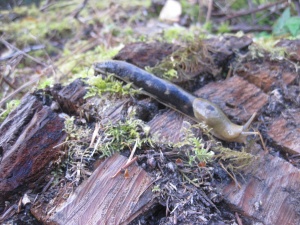Where the skiff meets the beach the sound of hundreds, if not thousands of small-flat weathered rocks clatter and scrape against each other as if in protest of having to move out of the way. I feel the same protest from under my Xtra-Tuf boots as I hop out of the boat and onto Pelican Beach at Cypress Island. The shore, as far as I can tell, is made up entirely of skipping stones, accented by a few large weathered logs. Once again, I think, no pelicans, and to the best of my knowledge few, if any have ever visited here. Maybe someone, some day will tell me the story of how Pelican Beach got its name.
It’s always tempting to sit down on a log and mindlessly sort through rocks, or spend the day watching the changing moods of Mount Baker while boats cruise though Bellingham Channel. The reason I continue up the beach is the 1.3 mile hike to the top of Eagle Cliff. It’s a moderately strenuous hike, but the effort is rewarded with one of the best views in the San Juan Islands.
Cypress Island is unusual in the San Juan Islands. It’s heavily forested and virtually unpopulated. As the fifth largest island in this highly developed archipelago it’s remarkable that 91% of the 5500 acres of land on the island is public. Cypress Island is managed by the Washington State Department of Natural Resources (DNR) and most of the land operated as a Natural Resources Conservation Area that’s reserved for outdoor recreation like the hike to Eagle Cliff, and the rest is protected as a Natural Area Preserve.

Rough skinned newts are one of Cypress Island’s many small treasures.
The hike to Eagle Cliff is through a predominantly Douglas fir forest, but there are also Western red cedars, Western hemlocks, and big leaf maples. I look forward to whatever I might find in the forest. My favorite two animals on Cypress are the poisonous rough skinned newt and the banana slug. As I walk the trail, I scan the ground for newts and slugs. I often have people with me who’ve never seen a newt or don’t really understand that there is such a thing as a good slug. So I watch the trail while trying my best to convince people that both of these animals are great subjects for wildlife photography since neither will bound away or fly off before you can get your camera ready.

A hard working banana slug feeds of leaf litter in the forest.
Rough skinned newts are undeniably cute with their biggish heads and bright-orange undersides that indicate their high level of toxicity. These seemingly sweet little amphibians are toxic enough to kill a person, but you’d have to eat one to be poisoned and since these newts are not aggressive, there’s really no harm in watching or photographing them up close. The banana slug is probably the biggest unsung hero of the Pacific Northwest. It’s main claim to fame is that it’s the mascot for the University of California, Santa Cruz, but there’s more to the banana slug. These obscenely large mollusks (the second largest slug in the world) are vital creatures of the forest. As detritivores, their role in the forest is that of a recycler, turning dead leaf litter and even animal scat into healthy soil. They are often easily found on the trail and rarely seem bothered by a handful of nature lovers with point-and-shoot cameras. I love watching these hard workers turn detritus into nutrients for big trees and small plants alike.
Ever since my first trip to Cypress island in the fall of 1997, I listen for ravens while walking the trail and looking for beloved newts and slugs. On that first trip, my group had briefly stopped at an exposed rock face that showed scarring from the ancient glaciers that once covered this area in ice a mile thick. While we were standing there rubbing our hands across the rock, we could hear the wind in the trees and voices coming from somewhere ahead of us and higher up. The voices were faint and foreign. Our party continued up the trail noting more of the glacial striations. As the trail rounded up and over to the very top we caught sight of the voices — they weren’t human, but rather ravens playing in the updraft. Their play caused us to forget that we’d come for the panorama of the San Juan Islands and the peek-a-boo view of Mt. Baker. The ravens, about a dozen of so were engaged in a game of “catch-the-shiny-thing.” It appeared that one raven would ride the updraft as high as it could with something in its beak. The others would give chase until the raven with the object dropped it. At that, all the birds tucked in their wings and dove quickly down the face of the cliff to catch the object. When one bird caught it, they all caught the updraft and repeated their actions. Their game gave me both chills and joy. It’s one of my most memorable days and one reason I come to Cypress Island over and over.
There is no ferry to Cypress Island which makes it a wonderful destination for boaters and kayakers. There are first-come-first serve mooring buoys at Pelican Beach, Cypress Head and Eagle Harbor. The Eagle Cliff trail is closed to the public from February 1 to July 15 each year to protect endangered and sensitive species and habitat. For more information about Cypress Island visit the DNRs’ website.
Christine Smith and her husband Jeffrey own Northwest Navigation Co. Northwest Navigation Co. offers small ship cruising aboard the Motor Vessel David B in the San Juan Islands, Inside Passage, and Southeast Alaska. For more information visit their website at NorthwestNavigation.com.


